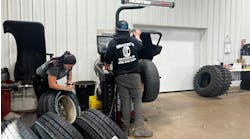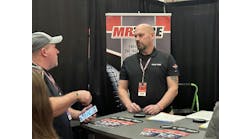There are now three levels of high-voltage technician certifications with regard to electric vehicle service safety.
ASE has classified a level one tech as being aware that high-voltage systems are dangerous. (By the way, once you know that a hybrid, plug-in hybrid, pure electric and even a fuel cell vehicle is in your bay — my company, Automotive Career Development Center, calls all of those an EMV — stay away from the orange-colored parts!)
Level two means you have all training, personal protective equipment and other equipment to service the entire EMV, except high-voltage battery repair. (Swapping the old HV battery with a new one is allowed, but remember to keep the lid on the battery packs.)
Level-three includes all of level-two, plus the training to get inside the HV pack and make repairs. (This is helpful, but how much time and money do you want to invest?)
With little to no regulations and EVs selling faster than most people thought they would, where do you lead your team?
First, it’s time for an assessment of your shop, the people who work there and the cost and return on your investment. I wrote a previous MTD EV Intelligence column about the cost of getting into EV service. This article is about when you should get in.
Anyone following the sales of new EVs in the U.S. would see a trend that EVs are more popular year-over-year than any other classification of light-duty vehicles. In other words, in just a few years, EVs — that means vehicles with no internal combustion engine at all — will make up more than 15% to 25% of total sales.
Should you go all-in on EVs? Let’s look at what happens when you say no. This means you will keep things the way they are now. For the short-term, you will most likely be more than OK.
What about doing some work on EVs? With that decision, at some point you must tell your customer, “Take it back to the EV dealership.” As a shop owner for more than 25 years during a lot of technology changes, that was not an option I felt was in my company’s best interest.
We invested in new air conditioning machines, scan tools, alignment racks, scopes and many other pieces of equipment. We invested in training for our technicians and managers. We made improvements in our building — moving locations twice — as well as office equipment.
This was expensive and stressful. But what choice did I have? It was either stay current with the times or fall behind.
I did make a big change that helped my bottom line, but it was risky. My shop, now a hybrid/EV training center, in a city of 200,000 was near many good shops. We first sold our tire machine and alignment machine — and sent that work — to a local shop, Moran’s Auto Service, as they were better at these services than us and had the latest equipment. It also freed up a bay — we had six — to do more profitable work.
That worked so well that we then sold our old air-conditioning equipment and funneled customers to Morris Auto Radiator for A/C service. I was on a roll!
The point here is to play to your strengths. My old business, Van Batenburg’s Garage Inc., was known for excellence in Honda and Acura service and repair. That attracted a good customer base, so we worked on their other Asian brands, too.
I assume tires and related work are your strength. And as I have come to know tire dealerships, many offer full-service, too. If you go for the low-hanging fruit with EVs, the chance of losing them will become real if you can’t take care of EV owners’ concerns. At Van Batenburg’s Garage, we sent some jobs to other good shops, but where can you send an EV? Most likely, back to the local dealer, where it was purchased by your customer.
In some cases, your options will be limited. Are there high-quality, independent EV service facilities near you? Do you have a mobile EV diagnostic technician in your area? Or is it time to offer EV service at your business and grow into it as the market changes?
Your customers may switch to an EV this year. Prices for a new EV have come down. Some buyers may qualify for a sizeable tax credit. For example, there is a $4,000 used EV credit that began on Jan. 1, 2023. If consumers buy a qualified used EV or fuel cell vehicle from a licensed dealer for $25,000 or less, they may be eligible for a used clean vehicle tax credit — also referred to as a previously owned clean vehicle credit.
Just the price drop alone is bringing in new buyers. In January 2022, EVs represented 4.3% of new car sales. This past January, the share was more than 7% That is growth. (Compare those figures to U.S. diesel light-duty vehicle sales at about 3%.)
Waiting to see when the market is ready means you may have missed the sweet spot when a competitor takes those customers away from you. If the timing seems right, the future looks good.




